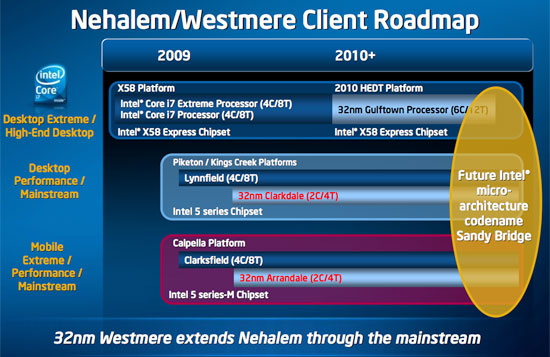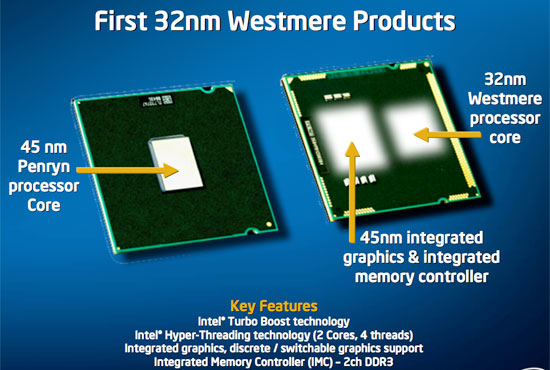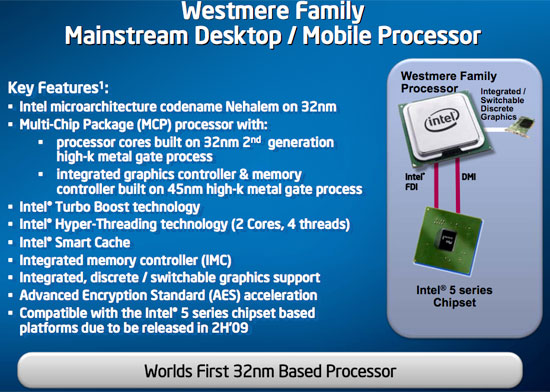Intel's 32nm Update: The Follow-on to Core i7 and More
by Anand Lal Shimpi on February 11, 2009 12:00 AM EST- Posted in
- CPUs
Enter the 32nm Lineup
Instead of Havendale in Q4, we’ll get Clarkdale and Arrandale. These are both dual-core, quad-thread processors, and both have on-package graphics. The CPU cores will be built on Intel’s 32nm process and in fact, they will be the first Westmere CPUs shipping into the market.

Now note that the dual-core market is the largest slice of the processor pie. Intel must be incredibly confident in its 32nm process to start shipping it into these demand markets first. Remember that both 65nm and 45nm initially launched on the high end desktop, but 32nm is making its debut in mainstream notebooks and desktops. The 32nm ramp is going to be a good one folks.
| Segment | Manufacturing Process | Socket | Processor | Cores | Threads | Release Date |
| High End Desktop | 32nm | LGA-1366 | Gulftown | 6 | 12 | 1H 2010 |
| Mainstream Desktop | 32nm | LGA-1156 | Clarkdale | 2 | 4 | Q4 2009 |
| Mobile | 32nm | mPGA-989 | Arrandale | 2 | 4 | Q4 2009 |
| 4S Server | 32nm | LGA-1567 | ??? | ? | ? | 2010 |
| 2S Server | 32nm | LGA-1366 | ??? | ? | ? | 2010 |
| 1S Server | 32nm | LGA-1156 | Clarkdale | 2 | 4 | 2010 |
Clarkdale/Arrandale have 32nm CPUs but their on-package GPUs are still built on Intel’s 45nm process; these are the GPUs that were supposed to be used for Havendale! It won’t be until 2010 with Sandy Bridge that we see a 32nm CPU and 32nm GPU on the same package.

A side effect of the Clarkdale/Arrandale architecture is that the memory controller is now located on the GPU and not the CPU, although both are still on package and should still be quite low latency.

Keep following; if you want a quad-core Westmere, your only option will be in the LGA-1366 socket with Gulftown. Core i7 will get replaced with a six-core, twelve-thread processor in early 2010. There won’t be a 32nm quad-core part on the desktop until the end of 2010 with Sandy Bridge.










64 Comments
View All Comments
Calin - Wednesday, February 11, 2009 - link
[quote]but at 45nm Intel’s switched from a SiO2 gate dielectric to a high-k one using Halfnium[/quote]It's Hafnium (even if halfnium sounds better)
aapocketz - Wednesday, February 11, 2009 - link
hafnium is great for dielectrics. I hope their yields are good since its very expensive. Most CVD processes are only efficient in the single digit %.MrPoletski - Wednesday, February 11, 2009 - link
doesn't sound as good as unobtanium.melgross - Wednesday, February 11, 2009 - link
I just don't see how AMD competes, long term. With Intel moving to 32nm faster than expected, and with mainstream parts, that would put them 18 months ahead of AMD, unless somehow, they manage to pull off a similar coup. But it doesn't look as though they will be able to.We might remember that a bit over a year ago, AMD stated quite boldly, that they would move to within 6 months of Intel's process changes, but they are still a year behind. No progress there. Unless they can manage to switch around their roadmap the way Intel seems to be able to do, they will fall further behind.
LordanSS - Wednesday, February 11, 2009 - link
I think we should wait and see how things will turn out. Now that AMD has spun off their fabs to a separate company, it's no longer their (AMD) job to invest on new manufacturing processes.Hopefully, now that the Foundry company has more "freedom", and injection of capital from sources outside of AMD, it'll be able to increase the pace of the shrinking processes.
Besides all that, doesn't AMD graphics division make use of TSMC's fabs to make their chips?
PrinceGaz - Wednesday, February 11, 2009 - link
TSMC's fabs will always be a generation or so behind the like of Intel's own, just as AMD (with IBM's assistance) were ahead of them in the past.I can't see AMDs fab company getting much outside investment in the current economic climate -- new state-of-the-art fab facilities are too expensive and there is no guarantee of profitable contracts to keep them busy. The Foundry Company is never going to catch up with Intel unless a miracle happens, and TSMC etc will likely be direct competitors.
Intel are speeding up their fab and process development because they have money in the bank and continued profits to fuel it. AMD are in dire-straits financially and making a loss. Even with the risks hedge-fund managers take, they'd be mad to put money into AMD just now.
Triple Omega - Sunday, February 15, 2009 - link
I wouldn't count AMD out just yet if I were you. One false move from Intel and an unexpected innovation from AMD and they're back on their feet. If in Q4 2007 you said Ati would level the playing field with Nvidia the following year most would call you crazy, yet it still happened. So I still have hopes for AMD.ucsdmike - Wednesday, February 11, 2009 - link
AMD's staff will be hitting the bar tomorrow.This is amazing news from Intel. It is an exciting move.
Looking forward to cooler and longer running laptops in the near future.
icecold101 - Monday, August 24, 2009 - link
AMD still has one thing that intel dosent have... low prices. these new cores will cost more than $1000! In the slumping economy it isn't the best time to ask for top dollar.Ryun - Thursday, February 12, 2009 - link
More reason to work extra hard maybe?In all seriousness, I have a feeling AMD might pull a rabbit out of it's hat like ATi did with the 4 series with their new architecture. Actually, technically they did with Phenom II but really it was just too late in the game to make the significant dent that ATi's 4 series did (though I'd say the triple cores this round are a big win).
At any rate, 2011 (Bulldozer, or whatever they're calling it now) better be huge. The 65nm X2s were somewhat competitive with Conroe, but after that it just started going downhill. If Bulldozer doesn't do it I don't think AMD is going to be able to get back up. =(